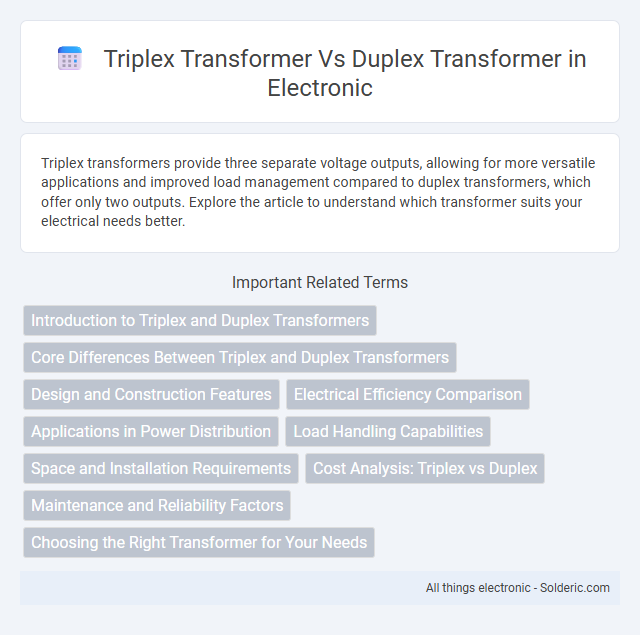Triplex transformers provide three separate voltage outputs, allowing for more versatile applications and improved load management compared to duplex transformers, which offer only two outputs. Explore the article to understand which transformer suits your electrical needs better.
Comparison Table
| Feature | Triplex Transformer | Duplex Transformer |
|---|---|---|
| Number of Windings | Three windings | Two windings |
| Primary Function | Used for three-phase power distribution and complex load balancing | Used for two separate circuits or dual voltage levels |
| Applications | Industrial plants, three-phase load systems | Residential and commercial electrical systems requiring two voltages |
| Voltage Configuration | Three separate voltages or phases | Two voltages or phases |
| Complexity | More complex design and cost | Less complex, cost-effective |
| Size & Weight | Larger and heavier due to extra winding | Smaller and lighter |
| Load Handling | Better suited for balanced three-phase loads | Designed for two load circuits or dual functionality |
Introduction to Triplex and Duplex Transformers
Triplex transformers are designed to provide three separate outputs from a single transformer, commonly used in applications requiring multiple voltage levels or phases. Duplex transformers, on the other hand, offer two outputs usually for balancing loads or supplying dual circuits. Understanding your power distribution needs helps determine whether a triplex or duplex transformer best supports your electrical system's efficiency and reliability.
Core Differences Between Triplex and Duplex Transformers
Triplex transformers feature three windings designed to supply three-phase power, maximizing efficiency and balancing loads in industrial applications. Duplex transformers have two windings, typically used for single-phase or split-phase power distribution, offering simpler design and lower cost. The core difference lies in phase delivery and winding configuration, where triplex transformers support three-phase systems, while duplex transformers cater to two-phase or single-phase requirements.
Design and Construction Features
Triplex transformers feature three separate cores or windings assembled into a single unit, enabling independent voltage regulation for each phase, which enhances fault isolation and load balancing. Duplex transformers consist of two windings or cores, primarily designed for simpler two-phase power distributions with less complexity in magnetic coupling and insulation. The triplex design incorporates intricate insulation materials and compact core arrangements to manage thermal performance and electromagnetic interference more effectively than duplex transformers.
Electrical Efficiency Comparison
Triplex transformers generally exhibit higher electrical efficiency compared to duplex transformers due to their design that optimizes load distribution and reduces energy loss in power systems. The triplex configuration minimizes core and copper losses by balancing the magnetic flux more effectively across three phases rather than two. This enhanced efficiency makes triplex transformers preferable in applications requiring sustained performance and minimal energy waste.
Applications in Power Distribution
Triplex transformers are commonly used in residential power distribution to provide three-phase power, supporting multiple single-phase loads with improved efficiency and balanced voltage delivery. Duplex transformers typically serve commercial or smaller industrial applications where two separate loads or circuits require distinct voltage levels, facilitating isolated power distribution. Both types enhance system reliability and enable tailored solutions for diverse power distribution needs, with triplex transformers excelling in complex, multi-load environments.
Load Handling Capabilities
Triplex transformers provide superior load handling capabilities compared to duplex transformers by efficiently managing three-phase electrical loads, ensuring balanced power distribution and minimizing voltage fluctuations across all three phases. Duplex transformers are designed primarily for single or dual-phase loads, which limits their capacity to handle higher, more complex demands common in industrial and commercial settings. Your choice between these transformers should consider the scale and nature of the electrical load to optimize performance and energy efficiency.
Space and Installation Requirements
Triplex transformers require less space compared to duplex transformers due to their integrated design that combines multiple core and coil units into a single compact enclosure. Installation of triplex transformers is more straightforward and cost-efficient, as they minimize the need for multiple mounting points and reduce wiring complexity. Conversely, duplex transformers, comprising two separate units, demand more room and intricate installation procedures, increasing labor and material costs.
Cost Analysis: Triplex vs Duplex
Triplex transformers typically incur higher upfront costs compared to duplex transformers due to their enhanced capacity and complexity. Your choice may depend on long-term operational savings, as triplex transformers can reduce maintenance expenses and improve efficiency in high-demand settings. Evaluating total cost of ownership, including installation and energy efficiency, helps determine the most cost-effective option between triplex and duplex transformers.
Maintenance and Reliability Factors
Triplex transformers require less frequent maintenance due to their integrated design, which reduces the number of components susceptible to failure compared to duplex transformers. Duplex transformers, with separate units for different phases, may experience uneven load distributions leading to increased wear and higher maintenance needs. Enhanced reliability in triplex transformers is often attributed to their simplified cooling systems and consolidated insulation, minimizing downtime in critical distribution networks.
Choosing the Right Transformer for Your Needs
Choosing the right transformer depends on your power distribution requirements and space constraints. Triplex transformers provide three secondary windings for more versatile voltage configurations and are ideal for complex multi-voltage systems, while duplex transformers offer two windings, suited for simpler, dual-voltage needs. Evaluating your electrical load and installation environment ensures your transformer matches your operational demands efficiently.
triplex transformer vs duplex transformer Infographic

 solderic.com
solderic.com